Research Articles
Latest articles
- Researchpp 890-907Guan, M., and Huang, Z. (2022). "Direct strain distribution and finite-element-analysis simulation of the bonding interface of bamboo laminated lumber with ultrasound-treated bamboo strips," BioResources 17(1), 890-907.AbstractArticlePDF
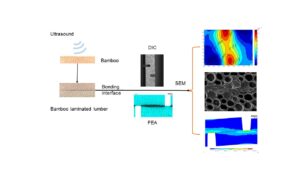
An ultrasonic cavitation treatment was used to increase the permeability of phenol formaldehyde resin adhesive on the surface of bamboo strips, and two-ply laminated bamboo lumber was manufactured. The strain distribution along the bamboo interface under stretching conditions was investigated using the digital image correlation technique. The effect of the ultrasonic treatment on the bamboo strips in terms of the shear strain of the laminated bamboo lumber was investigated, and a finite-element analysis for the bonding interface was carried out to evaluate whether the deformation measurement could predict the mechanical behavior differences of the laminated bamboo lumber. The digital image correlation and shear strength results show that the strain was lower in the bamboo bonding interface after ultrasonic treatment and the shear strength was enhanced due to the increased adhesive penetration. The digital image correlation measurement and finite-element analysis simulation both showed that stress was more concentrated, and the strain value and strain zone width was higher in the carbonized bamboo bonding interface than in the bleached bamboo bonding interface. The finite-element analysis results appeared to be in agreement with the digital image correlation test results.
- Researchpp 908-921Ngene, G. I., Roux, J.-C., and Lachenal, D. (2022). "Influence of Hollander beater refining on xylan extraction from hardwood paper pulp by cold caustic extraction and xylanase treatment," BioResources 17(1), 908-921.AbstractArticlePDF
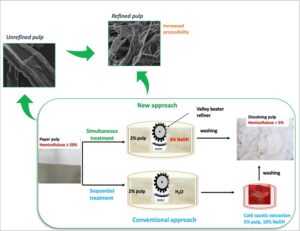
Cellulose fibers’ complex and compact structure hinders the quantitative extraction of residual hemicelluloses from the fiber wall. In this study, hardwood kraft paper pulp was subjected to refining with a Hollander beater at different refining loads (3, 4.5, and 5.5 kg) in order to assess the impact of refining load on xylan removal by cold caustic extraction. The refined pulp showed high water retention values and specific surface area, which increased accessibility and a correspondingly high degree of xylan removal. Coupling refining and cold caustic extraction (100 g/L soda) achieved over 50% more xylan removal than the unrefined pulp (3% against 7%, respectively). Furthermore, an improvement in xylan removal (79%) was achieved by implementing a one-pot simultaneous refining and cold caustic extraction treatment at half the time required for the sequential treatment and low soda concentration (60 g/L). Finally, the benefit of beating was also observed for xylanase treatment. Overall, the combined extractions made it possible to remove 85% of xylan from a conventional hardwood paper pulp giving rise to a high purity cellulose pulp with unimodal and narrow molecular mass distribution.
- Researchpp 922-938Sutrisno, E., Tanpichai, S., and Chuangchote, S. (2022). "Production of esterified nanofibrillated cellulose from a lesser-known wood Species (Macaranga hypoleuca)," BioResources 17(1), 922-938.AbstractArticlePDF
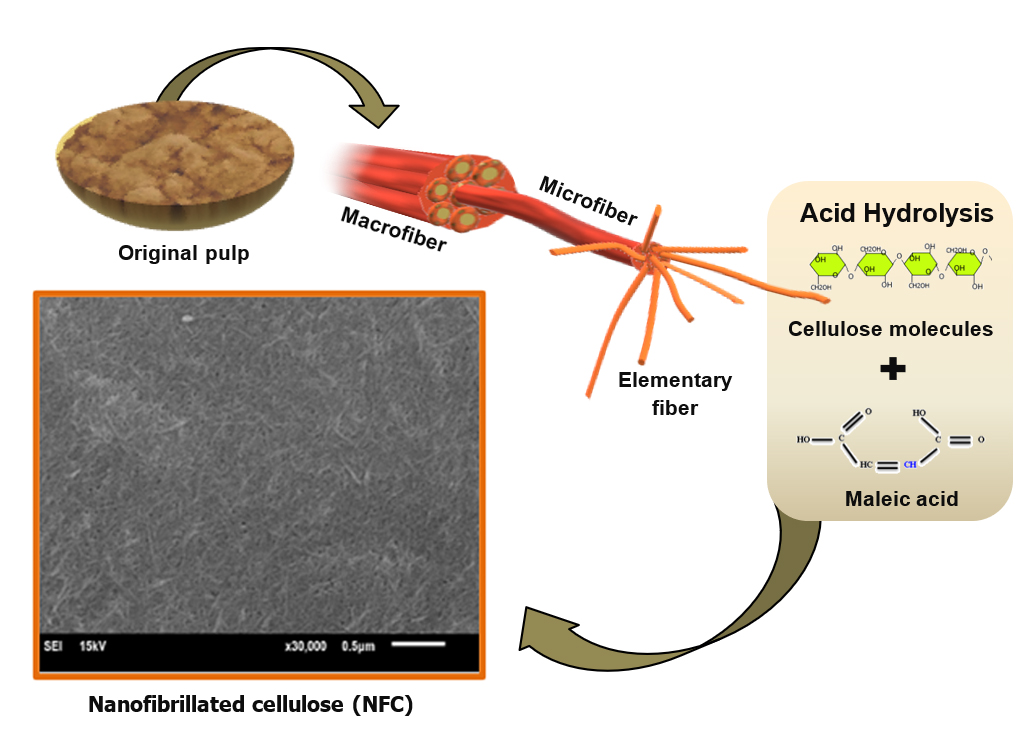
Macaranga hypoleuca, a lesser-known and rarely used wood species, is a pioneer species in the secondary succession that is classified as a fast-growing plant with long fibers. M. hypoleuca was composed of holocellulose, lignin, and extractives, at contents of 68.1 ± 0.5%, 25.5 ± 0.6%, and 4.7 ± 0.1%, respectively. In this study, refined M. hypoleuca pulp was treated by alkali treatment, delignification, and maleic acid hydrolysis. The pre-treated pulp was further disintegrated by mechanical treatment, which produced nanofibrillated cellulose (NFC) with a yield of 53.5 ± 2.7%. The average diameter of the NFC was 43.0 ± 4.9 nm. The use of maleic acid (C4H4O4) hydrolysis also reduced the hydrophilicity of the NFC, as confirmed by the Fourier-transform infrared (FTIR) spectra. It was determined that the Macaranga tree is a suitable lignocellulose source to produce NFC, which can be used in transparent flexible substrates, coating, and composite applications.
- Researchpp 939-951Luppold, W. G., and Bumgardner, M. S. (2022). "Analyzing changes in the U.S. wood furniture industry from 1997 to 2019: Production, net imports, and consumption," BioResources 17(1), 939-951.AbstractArticlePDF
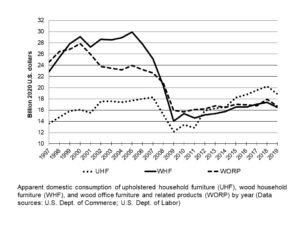
Wood-consuming furniture manufacturers (WCFM) are major users of forest products in the United States. Between 2000 and 2009, the real value of domestic WCFM shipments (production) declined by 51%. After 2009, WCFM shipments fluctuated, but by 2019 shipments were 48% below 2000 levels. A major contributor to this decline was furniture imports. In 1997, imports accounted for 6% and 23% of the value of upholstered household furniture (UHF) and wood household furniture (WHF), available to U.S. consumers, respectively. In 2019, imports accounted for 35% and 78% of domestically available UHF and WHF, respectively. The primary source of imported UHF in 2019 was China, while Vietnam was the most important source of WHF. Domestic consumption also influences WCFM shipments. Between 1997 and 2019, consumption of UHF by U.S. end-users increased; since 2002, this increase was primarily supplied through increased imports. Since 2005, domestic consumption of WHF declined by 45%, which contributed to the 75% decline in domestic shipments since that year. Wood office furniture and related products also have experienced a 40% decline in consumption since 2000, which coincided with a 41% decline in shipments. More research is needed to determine the impact of decreased WCFM shipments on U.S. forest product production and prices.
- Researchpp 952-961Lin, B., Liu, Y., Chen, Q., Ma, L., and Xu, J. (2022). "Totally chlorine free (TCF) bleaching of wheat straw soda-anthraquinone (AQ) pulp with a low initial kappa number," BioResources 17(1), 952-961.AbstractArticlePDF

The totally chlorine free (TCF) bleaching was studied for wheat straw soda-anthraquinone (AQ) pulp with a low kappa number of 8.3 using the sequence of OQPO and OQPOPO. It was found that the oxygen delignification on wheat straw pulp was still effective despite its low initial kappa number. A delignification extent of 42% and an ISO brightness increase of 10.9% were achieved. In the OQPO sequence, an ISO brightness ceiling of 87.2% was achieved as the hydrogen peroxide (H2O2) charge was increased from 2% to 6% in the PO stage. In the OQPOPO sequence, 2% H2O2 was added in the second PO stage and the pulp brightness exceeded 88% with a total charge of 4% H2O2 in the POPO bleaching. Higher brightness values of 89.5% and 90.1% were obtained under the total charges of 6% and 8% H2O2, respectively. Compared to the OQPO sequence, the higher brightness and equal viscosity of the bleached pulps were obtained under the same total charge of H2O2 in the OQPOPO sequence. The bleached pulps with high ISO brightness values (greater than 88%) retained acceptable strength properties. A slight decrease of fiber length occurred as the bleaching sequences proceeded, while the fiber width and curl index somewhat increased.
- Researchpp 962-974Tan, Y., Yang, X., Bai, X., Dong, H., Liu, J., and Zhang, L. (2022). "Inspection and evaluation of wood components of ancient buildings in the South-Three Courts of the Forbidden City," BioResources 17(1), 962-974.AbstractArticlePDF
Ancient architectural wood components were evaluated in terms of mechanical properties, material color expression, ultrasonic shape, chemical components, and deformation of shape and position by comparing them with new red pine materials. The results showed that the deterioration of the surface material properties of wood components was very serious, mainly caused by weathering. The attenuation degree of the inner layer of the wood component was relatively low, and the color change of the wood was obvious, which was mainly caused by fungi. Ultrasonic nondestructive testing technology was used to detect the internal damage of ancient wood components. According to the test results, it was speculated that the root defects of pillar components were serious. Three components of wood after long-term weathering changed significantly, and lignin had been seriously damaged. This damage was reflected in the degradation of the number of aromatic groups and the changes in the nature of the group. The main wood beams in the main halls of the three yards were bent at 0 mm offset scale and unit offsets of the pillars of the four courtyards were within the safe range.
- Researchpp 975-992Wang, J.-H., Mahmoud, M. S., and Mahmoud, A. S. (2022). "Integrated efficiency of using nanocellulose-nano zero valent iron composite in water treatment," BioResources 17(1), 975-992.AbstractArticlePDF

Water treatment using nano-materials can have a significant impact due to its surface properties. Coagulation techniques were studied by using 3 mL/L of 0.5% of different coagulants (polyacrylamide, poly aluminum chloride (PAC), ferric chloride, aluminum sulfate, and nanocellulose). Results indicated that the turbidity removal efficiency were 91.6%, 93.04%, 95.2%, 95.4%, and 99.4%, respectively. Treatment of water samples collected from the Ismailia Canal, the Damietta branch of the Nile Delta, and a wastewater treatment plant located in Cairo (Egypt) using nanocellulose fibers was studied. For the Ismailia Canal sample, the removal of turbidity, chemical oxygen demand (COD), biological oxygen demand (BOD), and phosphorous were 96%, 83.3%, 100%, and 100%, respectively. For the Damietta branch sample, the removal of turbidity, COD, BOD, and phosphorous were 87.5%, 81.3%, 88.9%, and 99.1%, respectively. For the wastewater treatment plant sample, the removal of turbidity, COD, BOD, and phosphorous were 86.4%, 91.96%, 92.86%, and 91.74%, respectively. Nanocellulose-nano zero-valent iron composite (NC-nZVI) was investigated for phosphorous removal at different operating conditions. Results showed phosphorous removal efficiencies of 91 and 100% for initial phosphate concentrations of 10 and 1 mg PO43– P/L, respectively. Different isothermal analyses were performed for monolayer and multilayer adsorption processes.
- Researchpp 993-1000Song, G., Qiao, H., Gu, H., and Cui, X. (2022). "Exergetic comparison of electrical heating gasification and water electrolysis assisted gasification for renewable electricity storage," BioResources 17(1), 993-1000.AbstractArticlePDF
To develop an efficient solution for the storage of renewable electricity and utilization of biomass or waste within the power-to-X concept, the electrical heating gasification (EHG) technology for industrial-scale application was proposed and compared with water electrolysis-assisted gasification (WEG). The two technologies were compared in terms of composition, yield, and exergy efficiency. The results indicate that EHG consumes less electricity and generates syngas with higher chemical exergy. The maximum exergy efficiency of EHG was calculated as 80.76%. Electrical heating gasification is more efficient than WEG based on either the current state or the potential progress in the future. Additionally, the exergy efficiency of water electrolysis ranges between 54.1% and 79.1%, which implies that more efforts are needed in the future to reduce the specific electricity consumption. This work is valuable to guide the development of an electrical heating gasifier and to improve performances of power-to-X technologies.
- Researchpp 1001-1014Guo, W., Wang, Z., Hu, F., Hou, Z., and De, X. (2022). "Parameter optimization study based on co-briquetting tests of corn straw and potato residue," BioResources, 17(1), 1001-1014.AbstractArticlePDF
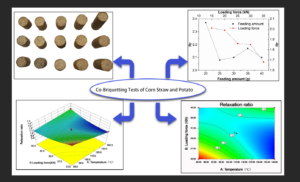
Corn straw and potato residue are common agricultural biomass. Although they have a wide range of applications, the disadvantages of low bulk density and high storage and transportation cost hinder their utilization. The densification of these biomass into briquettes facilitates their storage, transportation, and reuse. The rheological properties of corn straw and potato residue during co-briquetting were investigated in creep tests. The Four-element Burgers Model accurately and intuitively fit the creep curves of the mixed materials, with fitting coefficients above 0.99. The experiment used the relaxation ratio as an indicator, and the influence of compression speed, dwell time, feeding amount, loading force, mass ratio, and temperature were obtained. The response surface analysis indicated that all factors except compression speed had an effect on the relaxation ratio. The results suggested that compressing corn straw and potato residue in a feeding amount of 28 g with a mass ratio of 1:5 at 101 °C under 35 KN loading force and 918 s dwell time produces cost-effective agricultural biomass briquettes. This study provides a reference for improving the co-briquetting process of corn straw and potato residue.
- Researchpp 1015-1030Lang, Q., Zhang, C., Liu, C., Zhang, H., Zhang, S., Li, L., and Chen, H. (2022). "Viscoelastic and dynamic characteristics of wood-melamine-urea-formaldehyde composites prepared by in situ polymerization," BioResources 17(1), 1015-1030.AbstractArticlePDF
The viscoelastic behavior and the dynamic mechanical properties were studied for wood-melamine-urea-formaldehyde composites prepared from fast-growing poplars using in situ polymerization. The changes in stress relaxation (SR), storage modulus (E′), and damping parameter (tan δ) were considered. The relationship between the dynamic mechanical properties and the modifier concentration was also studied. The SR value decreased as the modifier content increased in all the samples examined. The urea content had a greater impact than the melamine-urea-formaldehyde mixture content on the SR value of the wood samples. A similar trend was observed for E′. The modified wood samples exhibited a higher tan δ. The results confirmed that a better interfacial interaction between melamine-urea-formaldehyde and wood fiber contributed to the improvement of mechanical properties in the fast-growing poplar wood.
